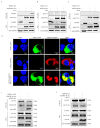TRIM21 Promotes Oxidative Stress and Ferroptosis through the SQSTM1-NRF2-KEAP1 Axis to Increase the Titers of H5N1 Highly Pathogenic Avian Influenza Virus
- PMID: 38542289
- PMCID: PMC10970474
- DOI: 10.3390/ijms25063315
TRIM21 Promotes Oxidative Stress and Ferroptosis through the SQSTM1-NRF2-KEAP1 Axis to Increase the Titers of H5N1 Highly Pathogenic Avian Influenza Virus
Abstract
Tripartite motif-containing protein 21 (TRIM21) is involved in signal transduction and antiviral responses through the ubiquitination of protein targets. TRIM21 was reported to be related to the imbalance of host cell homeostasis caused by viral infection. Our studies indicated that H5N1 highly pathogenic avian influenza virus (HPAIV) infection up-regulated TRIM21 expression in A549 cells. Western blot and qPCR results showed that knockdown of TRIM21 alleviated oxidative stress and ferroptosis induced by H5N1 HPAIV and promoted the activation of antioxidant pathways. Co-IP results showed that TRIM21 promoted oxidative stress and ferroptosis by regulating the SQSTM1-NRF2-KEAP1 axis by increasing SQSTM1 K63-linked polyubiquitination under the condition of HPAIV infection. In addition, TRIM21 attenuated the inhibitory effect of antioxidant NAC on HPAIV titers and enhanced the promoting effect of ferroptosis agonist Erastin on HPAIV titers. Our findings provide new insight into the role of TRIM21 in oxidative stress and ferroptosis induced by viral infection.
Keywords: NRF2; TRIM21; ferroptosis; influenza virus; oxidative stress.
Conflict of interest statement
The authors declare no conflicts of interest.
Figures







Similar articles
-
Overexpression of TRIM16 Reduces the Titer of H5N1 Highly Pathogenic Avian Influenza Virus and Promotes the Expression of Antioxidant Genes through Regulating the SQSTM1-NRF2-KEAP1 Axis.Viruses. 2023 Jan 30;15(2):391. doi: 10.3390/v15020391. Viruses. 2023. PMID: 36851605 Free PMC article.
-
Severe Fever with Thrombocytopenia Syndrome Virus NSs Interacts with TRIM21 To Activate the p62-Keap1-Nrf2 Pathway.J Virol. 2020 Feb 28;94(6):e01684-19. doi: 10.1128/JVI.01684-19. Print 2020 Feb 28. J Virol. 2020. PMID: 31852783 Free PMC article.
-
TRIM21-mediated ubiquitination of SQSTM1/p62 abolishes its Ser403 phosphorylation and enhances palmitic acid cytotoxicity.Autophagy. 2025 Jan;21(1):178-190. doi: 10.1080/15548627.2024.2394308. Epub 2024 Sep 10. Autophagy. 2025. PMID: 39172027 Free PMC article.
-
Xiaojianzhong decoction attenuates gastric mucosal injury by activating the p62/Keap1/Nrf2 signaling pathway to inhibit ferroptosis.Biomed Pharmacother. 2022 Nov;155:113631. doi: 10.1016/j.biopha.2022.113631. Epub 2022 Sep 16. Biomed Pharmacother. 2022. PMID: 36122518 Review.
-
Sequestered SQSTM1/p62 crosstalk with Keap1/NRF2 axis in hPDLCs promotes oxidative stress injury induced by periodontitis.Free Radic Biol Med. 2022 Sep;190:62-74. doi: 10.1016/j.freeradbiomed.2022.08.001. Epub 2022 Aug 5. Free Radic Biol Med. 2022. PMID: 35940517 Review.
Cited by
-
A comprehension and systematic insight into the interaction between ferroptosis and virus infection: The implications of mechanisms and strategies.Virulence. 2025 Dec;16(1):2532806. doi: 10.1080/21505594.2025.2532806. Epub 2025 Jul 14. Virulence. 2025. PMID: 40658446 Free PMC article. Review.
-
ELAVL1 promotes ferroptosis via the TRIM21/HOXD8 axis to inhibit osteogenic differentiation in congenital pseudoarticular tibia-derived mesenchymal stem cells.J Cell Commun Signal. 2025 May 21;19(2):e70016. doi: 10.1002/ccs3.70016. eCollection 2025 Jun. J Cell Commun Signal. 2025. PMID: 40401147 Free PMC article.
-
The Role of the Nrf2 Pathway in Airway Tissue Damage Due to Viral Respiratory Infections.Int J Mol Sci. 2024 Jun 27;25(13):7042. doi: 10.3390/ijms25137042. Int J Mol Sci. 2024. PMID: 39000157 Free PMC article. Review.
-
TRIM21 promotes type I interferon by inhibiting the autophagic degradation of STING via p62/SQSTM1 ubiquitination in systemic lupus erythematosus.Acta Biochim Biophys Sin (Shanghai). 2025 Mar 31;57(5):834-846. doi: 10.3724/abbs.2025046. Acta Biochim Biophys Sin (Shanghai). 2025. PMID: 40165656 Free PMC article.
-
African swine fever virus MGF505-3R facilitates ferroptosis to restrict TBK1-IRF3 pathway.Microbiol Spectr. 2025 Aug 5;13(8):e0342324. doi: 10.1128/spectrum.03423-24. Epub 2025 Jun 23. Microbiol Spectr. 2025. PMID: 40548711 Free PMC article.
References
-
- Subbarao K., Klimov A., Katz J., Regnery H., Lim W., Hall H., Swayne D., Bender C., Huang J., Hemphill M., et al. Characterization of an avian influenza A (H5N1) virus isolated from a child with a fatal respiratory illness. Science. 1998;279:393–396. doi: 10.1126/science.279.5349.393. - DOI - PubMed
MeSH terms
Substances
Grants and funding
LinkOut - more resources
Full Text Sources
Medical
Molecular Biology Databases

